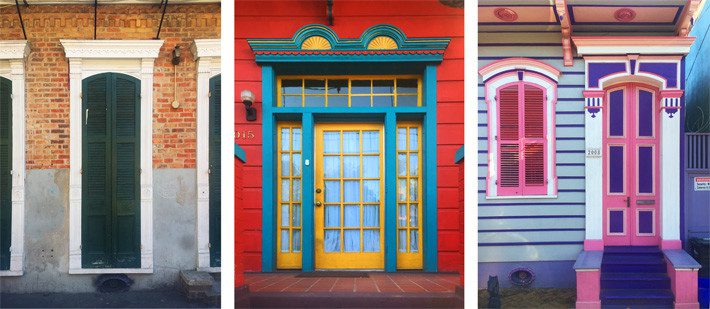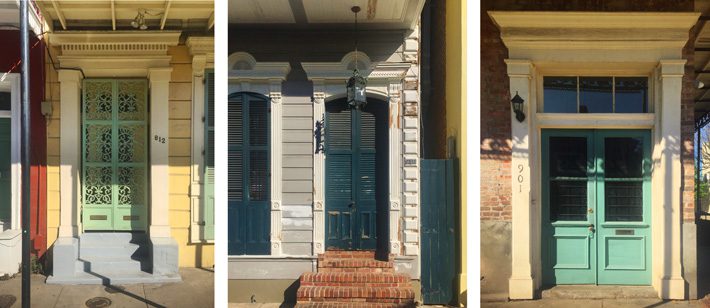Wood doors are an important character-defining feature for historic buildings and houses. Doors provide security, access, and visual rhythm to buildings. When properly maintained or restored, historic wood doors provide visual appeal, not just everyday functionality. The size, type, and arrangement of doors affect the articulation and appearance of historic buildings, and represent more than just the means to enter and exit a building.
Doors can be categorized into different types, and also have other distinguishing features and characteristics. Doors are placed in door frames and have hardware such as hinges, locks, latches, handles, and closers. Doors may have wood paneling, moldings, or even wood carving. They can also have panes of glass, known as lites. While doors are usually rectangular, they can be shaped to fit in arched openings with various profiles. These and other characteristics can used to describe historic doors.
A wood single door has a single panel of wood, known as a leaf, that is hung from hinges on side of the door frame. A wood double door has two leaves or panels of wood, with one leaf hung on each side of the doorframe. Wood double doors with lites in their two leaves are called French doors. Door frames may enclose merely the door, or may include other components such as windows, known as lites, including transoms windows, fan lites, and side lites. These lites can be described by the number of panes of glass they have.
The difference between a properly restored period door and an incompatible contemporary door can make a big impact on the visual appeal and overall character of a historic home in New Orleans. It is especially important to replace doors on a historic building with doors that are the same as or comparable to the original door in terms of dimensions, proportions, and profiles. Where possible, existing doors should be repaired or restored, especially on the front façade of buildings. Historic hardware can often be adjusted or rehabilitated to be fully functional. Having period hardware or compatible new hardware contributes to the historic character of doors, and should not be overlooked.
Doors can have a variety of finishes, including being painted, oiled, or stained and sealed. If it has lost its finish, it may be possible to sand and seal your door, in order to appreciate the wood and its grain. Otherwise, if it is fully painted or used to be fully painted, it may be most appropriate to repaint as needed. When preparing historic woodwork, especially wood molding and paneling such that seen on doors, any sanding should be done by hand, not with power tools or other abrasive cleaning techniques, to prevent excessive wear or damage to the wood profiles. If a door is to be repainted, then sanding should only be done reach the next sound layer of paint or to ensure full operability of the door, such as removing excess paint where a door leaf meets the frame. In any case, a historic door should have some form of finish treatment to safeguard against weathering and rot.
If an existing historic wood door is beyond reasonable repair or simply missing, or If prior renovations have replaced a door with one that is out of keeping with the original appearance of the building, you may wish to consider replacing it with a new or salvaged wood door compatible with the period and style of the home. In some cases, a home owner may be required to replace existing incompatible doors by Historic District Landmarks Commission or the Vieux Carr Commission if their home is located within a historic district in New Orleans. Architectural salvage yards may have period wood doors with the same dimensions and possibly frames, and are worth exploring if you need to replace a historic wood door. Alternatively, there are local woodworking shops that specialize in historic windows and doors, and are capable of fabricating new doors that match historic ones. Architectural salvage shops and yards may also have period appropriate door to replace any missing or incompatible wood doors.

Properly restored or maintained wood doors not only contribute to historic character of your home and neighborhood, but also the curb appeal and property value of your historic home.
See also the following for related information:
- Vieux Carr Commission and Dominique M. Hawkins. Guidelines for Windows & Doors. New Orleans: Vieux Carr Commission, City of New Orleans. August 2015. <http://www.nola.gov/getattachment/VCC/Design-Guidelines/VCC-07_WindowsDoors_2015-08_FINAL.PDF/>
- Historic District Landmarks Commission and Dominique M. Hawkins. Guidelines for Windows and Doors. New Orleans: Historic District Landmarks Commission, City of New Orleans. April 2015. <http://www.nola.gov/hdlc/documents/08_windows-doors_2015-04-24/>
- Vieux Carr Commission and Dominique M. Hawkins. Guidelines for Exterior Painting. New Orleans: Vieux Carr Commission, City of New Orleans. August 2015. <http://www.nola.gov/getattachment/VCC/Design-Guidelines/VCC-09_ExteriorPaint_2015-08_FINAL.PDF/>
- Kay D. Weeks and David W. Look. Preservation Brief No. 9: Exterior Paint Problems on Historic Woodwork. Washington DC: National Park Service, Technical Preservation Services. 1982. <https://www.nps.gov/tps/how-to-preserve/briefs/10-paint-problems.htm>
- Anne E. Grimmer. Preservation Brief No. 6: Dangers of Abrasive Cleaning to Historic Buildings. Washington DC: National Park Service, Technical Preservation Services. June 1979. <https://www.nps.gov/tps/how-to-preserve/briefs/6-dangers-abrasive-cleaning.htm>
Image credits: Windows and doors in New Orleans, photographs by Scott Heath, used with permission.





